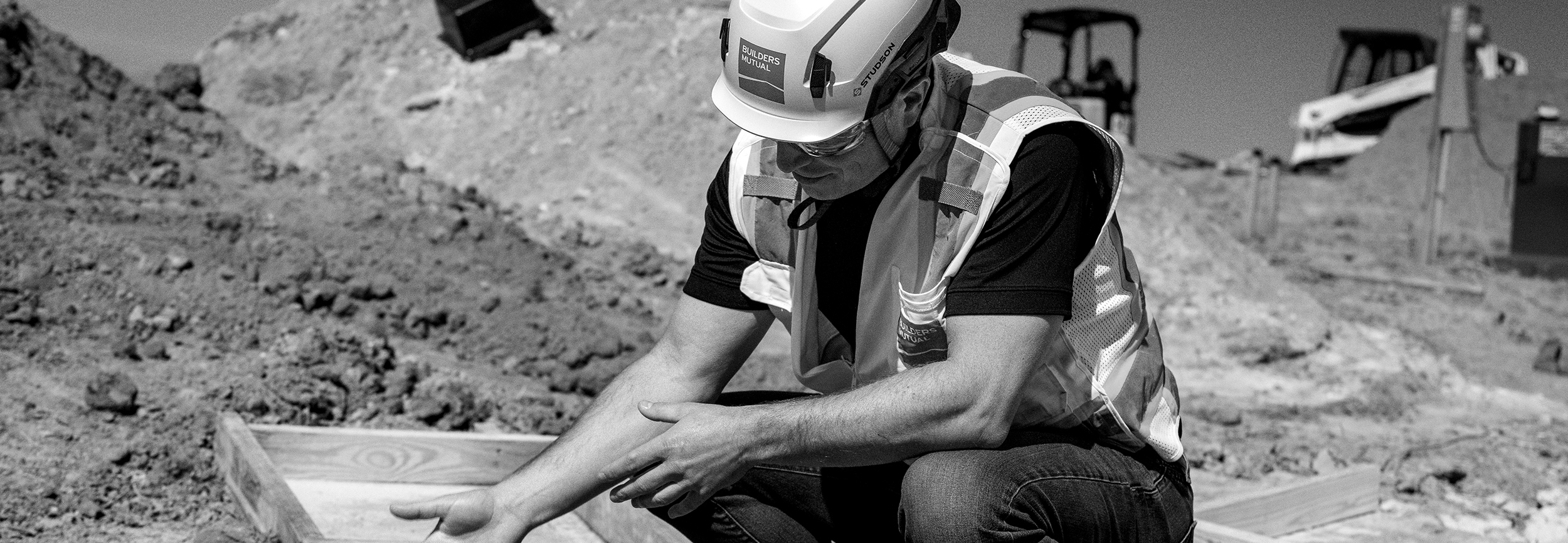Starting an in-house safety program from the ground up can feel overwhelming. The stakes are high (i.e., the health of your crews) and the number of steps seemingly unmanageable.
For any size contractor, the key to launching a safety program is starting with your strengths. If your team is an expert at safety training, or is experienced with identifying hazards, then begin with those pieces. Once you’re able to build on success, then you’ll have the momentum to complete the rest of your program.
That’s the advice of Lou Bueno, Senior Risk Management Consultant at Builders Mutual, who has helped scores of contractors develop their own safety programs. With the arrival of this month’s OSHA’s Safe + Sound Week, a nationwide event that recognizes the successes of workplace safety programs, now is the ideal time to focus on safety. In this article, Lou shares his tips on what goes into creating an effective approach to keeping your workers safe.
Benefits of safety programs
A safety program provides obvious advantages to your crews: preventing injuries and improving their health.
But as OSHA says, safe workplaces are also sound businesses. A well-developed safety program can lead to:
- Better quality control. With workers focused on their tasks instead of their safety, they can perform better and keep standards high.
- Increased employee retention. Workers recognize a workplace that values their health. Employees are less likely to leave and more likely to return to safer organizations.
- Stronger teamwork. When workers share a common goal of a safer workplace, they’ll look out for each other’s wellbeing.
Core components of a safety program
In Lou’s experience, safety programs should feature four main components that work together to produce a safer workplace:
- Management commitment and employee engagement
- Workplace analysis
- Hazard prevention and control
- Safety training
Let’s take a closer look at each area:
Management commitment and employee engagement
When safety is prioritized from the top levels of a business, workers can trust management’s commitment will flow through the rest of the organization.
At the most basic level, this commitment takes shape in the form of a safety manual. This documentation not only spells out the safety rules that are expected to be followed at the job-site, but also demonstrates what focus areas leadership is managing to.
In addition, it’s important that management “walk the walk.” Leadership needs to provide the resources to implement the program, and recognize or reward safe behavior. And safety rules are only as good as how thoroughly they’re understood. Communicate to your crews frequently, and make safety part of your daily conversation.
Bueno stresses, though, that safety is a two-way street. Employees need to also take responsibility for their own safety instead of placing the entire burden on management. That means following rules and keeping aware of company policies around safe workplaces.
Workplace analysis
This part of the safety program involves setting up procedures that ensure a safe work environment. That includes establishing a housekeeping policy that fosters a clean job-site, as well as a plan for evaluating risks associated with all construction tasks. For example, in an excavation, not only will you want to select the right equipment, but you’ll also want to assess the soil itself to determine how likely it may trap workers inside a trench.
Employee engagement stretches into workplace analysis, too. Your crew is often the ones most familiar with potential hazards. Invite them to participate in conducting site investigations, analyzing hazards associated with routine and nonroutine jobs, and defining safe work practices.
Hazard prevention and control
In many cases, foremen and supervisors don’t understand their risk exposure until after an accident has happened. That’s when an underlying problem is discovered or a new safety policy is implemented.
Of course, removing hazards is necessary. But finding and fixing hazards using a proactive approach is more effective at preventing injuries from reoccurring. That includes:
- Reporting incidents in a timely manner
- Investigating incidents to identify root causes
- Conducting inspections to identify emerging hazards
Safety training
All employees benefit from regular safety training that explains and reinforces safety policies and best practices. But training particularly helps new employees, who may not be familiar with the hazards present at a job-site. In their first year on the job, almost two-thirds of new hires are involved in an accident.
Ongoing safety training should be delivered in bite-size pieces of information that can be easily remembered. Even better, these reminders should be incorporated into a person’s workflow so they can learn by doing.
If creating your own safety program still feels like a lot, don’t worry. You don’t have to do it alone.
Builders Mutual offers a range of services and resources that can help you customize a safety program for your business:
- Risk assessment audit. Our risk management consultants can visit your job-site and work with your management team to identify potential hazards and opportunities to improve.
- Sample materials. Builders Mutual offers sample safety manuals as well as representative safety programs in the areas of excavation, fall protection, and personal protective equipment to benchmark against your own.
- Safety training. Our consultants can do more than recommend training best practices. We can also serve as guest speakers for training sessions.
Looking to enhance safety on your job-sites? Check out Builders Mutual’s WorkSafe library to educate, review, and sign-off on the key topics that every employee should know before stepping on the job-site.




 Find an
Find an